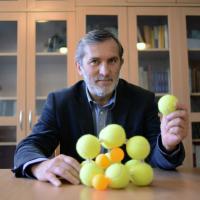Mechanoperovskites – the future of solar power engineering
Grinding chemical substances is not normally associated with modern technologies. Still, professor Janusz Lewiński with his team from the Environmental Laboratory of Functional Materials and Nanotechnology of the Warsaw University of Technology Faculty of Chemistry and the Institute of Physical Chemistry of the Polish Academy of Sciences prove that the truth is completely different.
Perovskites are a large group of materials with a specific spatial crystal structure. A perovskite, found in nature as a mineral, is composed of calcium titanium oxide CaTiO3, in which calcium atoms are placed in the corners of the cube and in the middle of each face there is an atom of oxygen, and inside the cube there is titanium.
Why do we need perovskites?
For synthesis of perovskites, one may easily use many organic and inorganic compounds and their appropriate choice determines their various physical and chemical properties needed. Thanks to this, in quite a simple way, they may be used for different purposes, e.g. for superconducting electromagnets, high-voltage transformers and RAM memory. Perovskites also absorb light very well, so they are used for construction of solar cells of the new generation. Development of a cheap process of perovskite production would revolutionise photovoltaic cells.
Too simple to be true?
According to professor Janusz Lewiński, complicated and expensive synthesis methods, high temperatures and solvents are not necessary. Perovskites, photovoltaic materials of the future, can be produced in a surprisingly simple way in reactions induced by mechanical force. The mechanical-chemical method of obtaining perovskites used by the scientists is simple, efficient and environmentally-friendly. – Perovskites are materials of the future and mechanical chemistry is the future of perovskites - professor Lewiński stressed.
– Into a ball mill, we put two powders: a white one, i.e. methylammonium iodide CH3NH3I, and a yellow one, i.e. lead iodide PbI2 – the process is explained by Anna Maria Cieślak, a doctoral student of the Institute of Physical Chemistry of the Polish Academy of Sciences. – After several minutes of grinding, the substrates are gone and in this simple way we obtain a homogenous black powder, perovskite CH3NH3PbI3.
There are more discoveries
Professor Lewiński stresses that with mechanical chemistry his team can synthetise various hybrid inorganic-organic functional materials of possibly great importance for power engineering. Obtaining perovskites in this way is a recent discovery of the scientists.
Interestingly, the perovskite obtained in a mechanical-chemical way in close cooperation with the team of professor Michael Graetzel (world pioneer in the field of photovoltaics) from Ecole Polytechnique de Lausanne in Switzerland, was used for construction of a laboratory solar cell. The efficiency of the cell based on the perovskite obtained in a mechanical-chemical way was over 10% greater than the efficiency of an equivalent cell obtained with the traditional solvent method.
Results of the work of the scientists led by professor Janusz Lewiński have enabled them to start stable international cooperation with European research centres and companies. The cooperation is developed in the project GOTSolar financed from the funds of the European Commission in the action Future and Emerging Technologies of the Horizon 2020 programme.
The results of the research have also been a basis of awarding one member of the team, Daniel Prochowicz, Ph.D., with a prestigious grant in the action ”Marie Skłodowska-Curie” of the Horizon 2020 programme. He has an opportunity to conduct innovative research in the team of professor Michael Graetzel.
Research on mechanical-chemical methods of production of 3D-structure materials was financed from the grants TEAM and MASTER of the Foundation for Polish Science.
Scientific publications:
”Mechanosynthesis of the Hybrid Perovskite CH3NH3PbI3: Characterization and the Corresponding Solar Cell Efficiency ”; D. Prochowicz, M. Franckevičius, A. M. Cieślak, S. M. Zakeeruddin, M. Grätzel, J. Lewiński; Journal of Materials Chemistry A, 2015, 3, 20772-20777; DOI: 10.1039/C5TA04904K








